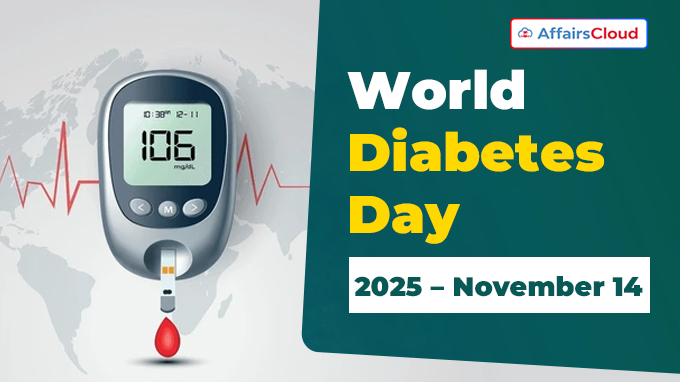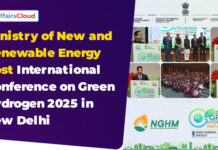The United Nations (UN) commemorates World Diabetes Day (WDD) every year on 14 November to raise global awareness about the impact of diabetes, the importance of prevention, early diagnosis, effective treatment, and equitable access to care.
Theme:
2025 Theme: “Diabetes across life stages”
Focus: The theme emphasizes the importance of a life-course approach to diabetes prevention, management, and well-being.
Exam Hints:
- What? World Diabetes Day (WDD) 2025
- When? 14 November
2025 Theme: “Diabetes across life stages” - Significance: Birth anniversary of Sir Frederick Grant Banting (discovered insulin)
- Initiated By? IDF and WHO in 1991.
- First UN WDD: 14 November 2007
- 2025 Event in India: Launch of Phenome National Conclave on Longitudinal Cohort Studies
- Where? CSIR–IMMT, Bhubaneswar, Odisha
- Launched by: Union MoS, Dr. Jitendra Singh
Background:
Origin: WDD was established in 1991 by the International Diabetes Federation (IDF) and the World Health Organization (WHO) to address the growing health threat posed by diabetes.
Observation: Since 1991, WDD has been observed globally on 14 November by the IDF.
UN Recognition: On 20 December 2006, the United Nations General Assembly (UNGA) adopted resolution A/RES/61/225, designating 14 November as an official UN Day to be observed annually starting in 2007.
First UN WDD: The first UN-recognized World Diabetes Day was observed on 14 November 2007.
Logo: The blue circle, introduced by IDF in 2006 as the universal symbol of diabetes, represents global unity in fighting the disease and was incorporated into IDF’s hummingbird logo in 2023.
Significance of Date: 14 November marks the birth anniversary of Sir Frederick Grant Banting, the Canadian scientist who co-discovered insulin in 1922.
- He, along with John James Rickard Macleod, received the 1923 Nobel Prize in Physiology or Medicine for the discovery of insulin.
Overview of Diabetes:
Definition: A chronic disease where insufficient insulin production or ineffective insulin use leads to high blood glucose, causing complications like blindness, kidney failure, heart disease, stroke, and amputations.
Types:
- Type 1: Lack of insulin production, previously called insulin-dependent or childhood-onset diabetes.
- Type 2: Ineffective insulin use, often linked to obesity and inactivity, formerly non-insulin-dependent or adult-onset diabetes.
Gestational Diabetes: Hyperglycemia first recognized during pregnancy.
Prediabetes: Elevated blood sugar not yet diabetic; reversible with lifestyle changes.
Targets: In 2022, WHO Member States set five global diabetes coverage targets for 2030: Diagnosing 80% of people with diabetes; ensuring 80% of those diagnosed have controlled blood sugar and 80% have controlled blood pressure; providing statins to 60% of patients aged 40+; and guaranteeing universal access to affordable insulin and glucose self-monitoring for all with type 1 diabetes.
Key Facts:
Future Projection: The International Diabetes Federation(IDF) estimates that by 2050, one in eight adults worldwide will be living with diabetes.
Access Gap: Only around 50% of people with type 2 diabetes receive the insulin they need, largely due to limited affordability within national health systems.
2025 Event in India:
Launch of ‘Cohort Connect 2025’: On 13 November 2025, Union Minister of State(MoS) (Independent Charge, IC), Dr. Jitendra Sing, Ministry of Science & Technology, MoS&T, launched the “Phenome National Conclave on Longitudinal Cohort Studies: Cohort Connect 2025” at Council of Scientific and Industrial Research – Institute of Minerals and Materials Technology (CSIR–IMMT), Bhubaneswar, Odisha on the eve of World Diabetes Day (WDD) (14 November).
Insight: Cohort Connect 2025 is part of the CSIR-led Phenome India initiative and serves as India’s largest evidence-based study on genetic, lifestyle, and environmental determinants of disease.
About International Diabetes Federation (IDF):
President– Professor Peter Schwarz (Germany)
Headquarters – Brussels, Belgium
Established – 1950





